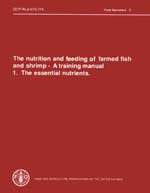THE NUTRITION AND FEEDING OF FARMED FISH AND SHRIMP - A TRAINING MANUAL
Albert G.J. Tacon

This document is based on the original lecture texts presented by Dr. A.G.J. Tacon to the trainees of the Fourth Senior Aquaculturists Training Course in Pirassununga, Brazil, from 13 June to 9 July 1986 (based at the Centro de Pesquisa e Treinamento em Aquicultura, CEPTA), and has been revised and updated as a training manual to form the basis of an intensive five week subregional training course on the nutrition and feeding of farmed fish and shrimp to be implemented by the FAO Trust Fund GCP/RLA/075/ITA Project within the Latin America and Caribbean Region. The aim of this training course is to create a core of senior instructors and researchers within the Region who inturn will be able to conduct their own national aquaculture nutrition and feeding training programmes, and advise farmers and researchers alike on all aspects of practical feed technology.
Although numerous training manuals exist on the nutrition and feeding of farmed fish and shrimp, these have tended to deal almost exclusively with intensive or complete diet feeding, with little or no mention of semi-intensive feeding methods. Since the majority of finfish and shrimp aquaculture production is currently realised within semi-intensive farming systems, clearly emphasis must also be given to semi-intensive feeding methods such as fertilization, composting, and supplementary diet feeding. All too often it is believed that the only economic way of feeding fish or shrimp is by using a high quality ‘complete’ pelleted diet; it is not, and farmers and researchers alike should not be misguided to believe so. Furthermore, the present manual critically assesses the known nutrient requirements of the major cultured aquaculture species, the methodology used by researchers for the measurement of dietary nutrient requirements and for conducting feeding trials, reviews the semi-intensive and intensive feeding strategies employed in other parts of the world, and attempts to open avenues for the development of an applied aquaculture nutrition and feeding research strategy to suit the needs and desires of the Latin America and Caribbean Region. The training manual is presented in four parts; part 1 deals with the essential nutrients, part 2 deals with nutrient sources, part 3 deals with intensive feeding methods, and part 4 deals with semi-intensive feeding methods.
"Tài liệu điện tử trên trang tepbac được chia sẻ để sử dụng cho mục đích học tập và nghiên cứu cá nhân. Nghiêm cấm mọi hình thức sao chép, in ấn phục vụ các mục đích khác nếu không được sự chấp nhận của tác giả và nhà xuất bản."









